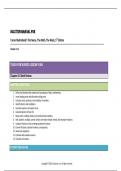Solution Manual for
Turner Mulholland’s The Nurse, The Math, The Meds, 5 th Edition
Chapter 1-13
TEACH FOR NURSES LESSON PLAN
Chapter 01: Math Review
CHAPTER OBJECTIVES
1. Define and interpret the symbols and vocabulary of basic mathematics.
2. Insert leading zeros and eliminate trailing zeros.
3. Calculate sums, products, and multiples of numbers.
4. Identify factors and multipliers.
5. Calculate squares and square roots.
6. Calculate powers of base 10.
7. Read, write, multiply, divide, and round decimal numbers.
8. Add, subtract, multiply, cancel, divide, and reduce simple, mixed, and improper fractions.
9. Compare fraction size by creating equivalent fractions.
10. Convert fractions, decimal numbers, and percents.
11. Solve basic equations.
12. Estimate and evaluate answers.
13. Calculate unit values.
STUDENT RESOURCES
Copyright © 2023 by Elsevier, Inc. All rights reserved.
,understand Textbook Chapter 01
apply Elsevier’s Interactive Drug Calculation Application
INSTRUCTOR RESOURCES
before class Nursing Curriculum Standards (below)
in class PowerPoint Presentations (Evolve)
Image Collection (Evolve)
Learning Activities (below)
Discussion Topics (below)
after class Test Bank (Evolve)
Drug Label Glossary (Evolve)
TEACHING STRATEGIES
Content Focus Content Highlights Learning Activities Resources
ESSENTIAL MATH Review the essential math vocabulary. Activity: Have the students bring their PPT slide 3
VOCABULARY AND text to class. Divide the students up
CONCEPTS Make sure that the students are not confused into groups of three and practice
about the symbols and understand that it is solving 10 practice questions from
safer if most, if not all, of the symbols are not Chapter 01.
used and are written out in words instead.
WHOLE NUMBERS Provide the students with different types of Activity: Make cards with individual PPT slides 4-6
handwriting that use both leading and trailing Roman numerals (I, V, X, and so on)
Multiplying and Dividing zeros and implied decimal points. Have them on each card. On other cards, write
Whole Numbers by the discuss which ones are difficult to decipher Arabic numbers (1, 5, 10, 14, 15, and
Number 1 and how easily handwriting can be misread in so on). Divide the students into
the midst of a busy shift. groups of three. Have the students
IMPLIED DECIMAL POINTS match the Arabic numbers to Roman
AND TRAILING ZEROS numerals using the cards. Have a set
of cards for each student group.
Dividing a Number or
Fraction By Itself
Copyright © 2023 by Elsevier, Inc. All rights reserved.
,TEACHING STRATEGIES
Content Focus Content Highlights Learning Activities Resources
SUM Discuss the different meanings of the word Activity: Give the students several
factor. Explain that many times familiar words numbers and groups of numbers and
PRODUCT can have meanings other than the one we have them write the factors and the
typically associate to them. common factors. Instruct them to
FACTOR exchange papers for grading and
discussion.
COMMON FACTORS
Common Factors Other
Than 1
MULTIPLE Emphasize the difference between factors and Online Activity: Go to
multiples. Write several problems on the https://www.ismp.org/tools/
FACTORS VERSUS board: addition, multiplication, subtraction, errorpronea reviations p . Start an
MULTIPLES and division. Label the parts of the problems, online journal by reviewing the
discussing that these labels learned in symbols that may lead to medication
MULTIPLIER elementary school are even now important. errors, recording the symbols to avoid
and identifying the alternatives to the
DIVISOR, DIVIDEND, symbols. Note: The journal will be
QUOTIENT, AND ongoing with directions for entries for
REMAINDER future chapters.
SQUARE Examine the uses of squares and square roots Discussion Topic: Ask the students to PPT slide 7
in medication administration. share tips on how they remember
SQUARE ROOT terms and differentiate among
mathematic processes. Do they use
mnemonics, acronyms, songs, or
other memory tricks?
BASES AND EXPONENTS Give the students some examples of bases and Activity: Have the students practice PPT slides 8-9
exponents in both numerical form and in how to read the bases and exponents
POWERS OF 10 written form. Have them change them to the expressions in the book.
CALCULATIONS opposite form.
Copyright © 2023 by Elsevier, Inc. All rights reserved.
, TEACHING STRATEGIES
Content Focus Content Highlights Learning Activities Resources
MULTIPLYING AND
DIVIDING BY 10, 100, 1000
DECIMAL FRACTIONS Explain that the number of digits to the right Activity: Bring different manikin PPT slides 10-14
of the decimal point is the number of zeros in wounds to class. Have the students
READING NUMBERS AND the denominator that is a power of 10 in a measure the wound in inches. Convert
DECIMALS decimal fraction. the fractions to decimals (e.g., a
wound that measures 4 ¼ inches
DECIMAL POINT SPATIAL Emphasize the importance of writing the would be converted to 4.25 inches).
PLACEMENT decimal point neatly and clearly to avoid any Small Group Activity: Group the
confusion. students in such a way that each
WRITING DECIMALS AS group has both strong and weak
FRACTIONS Give the students numerous problems to work students in the area of math. Practice
so they clearly understand how to identify the reading decimals aloud and writing
DECIMALS: WHICH IS larger of a pair of decimals. properly and accurately what is
LARGER? spoken. Encourage students to
Give examples of medications that should be provide feedback to each other.
ROUNDING DECIMALS rounded to either the nearest tenth or the
nearest hundredth.
ADDING AND
SUBTRACTING DECIMALS Emphasize the importance of keeping the
decimal points aligned when working
MULTIPLYING DECIMALS problems (excluding multiplication). Many
students have trouble with this, so allow time
DIVIDING DECIMALS for plenty of practice.
Division of Decimals Review where to insert a decimal into a
When the Divisor is a product that does not have enough digits in
Whole Number the answer.
Division of Decimals Work several division problems on the board,
When the Divisor Contains demonstrating clearly how to move the
Decimals decimal point when necessary.
Copyright © 2023 by Elsevier, Inc. All rights reserved.




